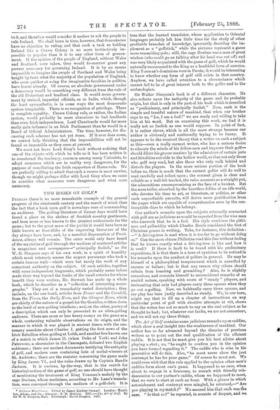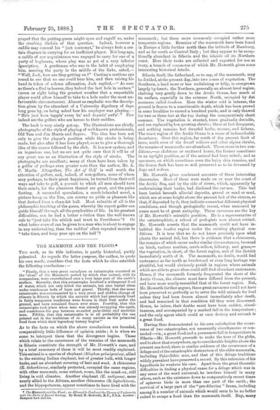TWO BOOKS ON GOLF.* PERHAPS there is no more remarkable
example of the general progress of the nineteenth century and the march of mind, than the fact that a book upon golf is nowadays sure of commanding an audience. The golfing literature of former days would have found a place on the shelves of Scottish country gentlemen, and been more or less known to the greatest enthusiasts for the game; but to the great mass of the public it would have been as little known as four-fifths of the improving literature of the
day always have been, and, by a merciful dispensation of Provi-
dence, always will remain. The outer world only have heard of the mysteries of golf through the medium of scattered articles in magazines and newspapers—" principally foolish," as Sir W. G. Simpson says of his own work, in a spirit of humility which must intensely amuse the august personage who took a certain famous walk—which were but rarely the work of any competent authority on the subject. Of such articles, together with some independent fragments, which probably never before made their way beyond the limits of the small coteries for whose benefit they were written, Mr. Stewart has made up a whole book, which he describes as a "collection of interesting mono- graphs." They are of a remarkably varied description ; they include, on the one hand, articles from Fraser and the Cornhill, from the Times, the Daily News, and the Glasgow News, which are chiefly of the nature of a gospel for the Gentiles, written down to the level of non-golfing intellects; and, on the other, poetry of a description which can only be presented to an ultra-golfing audience. There are more or less heavy essays on the game as a whole, containing valuable observations on its origin, and the manner in which it was played in ancient times, with the cus- tomary anecdote about Charles I. getting the first news of the Irish Rebellion when golfing at Leith, and another less known one of a match in which James II. (when Duke of York) and John Patersone, a shoemaker in the Canongate, defeated two English noblemen ; there are ancient documents testifying the antiquity of golf, and modern ones containing lists of medal-winners at St. Andrews; there are the statutes concerning the game made by King James VI., and the rules drawn up by Captain Randle Jackson. It is curious, by-the-way, that in the search for historical notices of the game of golf, no one should have thought of mentioning the treatment of King Youman's malady by the sage Dooban, whose medicines, according to Mr. Lane's transla- tion, were conveyed through the medium of a golf-club. It is
• Golfiana IfisreHanca. Edited by James Lindsay Stewart. London Hamil- ton, Adonis, and Co.; Glavgow T. D. Morison. 1887.—The Art of Golf. By Sir W. G. Simpson, Bart. Edinburgh; David Douglas. 11:07.
true that the learned translator, whose application to Oriental languages probably left him little time for the study of other profitable branches of knowledge, ignorantly describes the im- plement as a " goffstick," while the pictures represent a game more resembling polo; still, the sage Douban was a man of great wisdom (who could go on talking after his head was cut off) and was very likely acquainted with the game of golf, which he would naturally recommend to the King as a healthful form of exercise. King Yonman's dominions were in Persia; it would be interesting to know whether any form of golf still exists in that country. Anyhow, we have called attention to a circumstance which cannot fail to be of great interest both to the golfer and to the archzeologian.
Sir Walter Simpson's book is of a different character. He also reflects upon the antiquity of the game and its probable origin, but that is only in the part of his book which is described as "preliminary, and principally foolish." Now, each is the simple and trustful nature of mankind, that when our brother says to us, "Lo, I am a fool !" we are ready and willing to take him at his word. But on examining this work, we find it is really not so foolish as one would suppose. In point of fact, it is rather clever, which is all the more strange because our author is obviously and confessedly trying to be funny. It appears to be the received theory that a writer on such a subject as this—even a really earnest writer, who has a serious desire to educate the minds of his fellow-men and improve their golf—should dilate his graver maxims by the admixture of certain jests and frivolities suitable to the hollow world, so that not only those who golf may read, but also those who only walk behind and disturb the players. In the more serious portion of the book before us, there is much that the earnest golfer will do well to read carefully and reflect upon ; the counsel given is clear and reliable as a well-hit teeshot, the rules accurate as a straight put, the admonitions uncompromising as the face of a bunker. But the mere trifler, absorbed by the heartless follies of an idle world, who devotes his time to art, or literature, or politics, or other such unprofitable pursuits, will derive more gratification from the pages which are capable of comprehension even by the con- temptible class to which he belongs.
Our author's remarks upon the subjects externally connected with golf are as judicious as would be expected from the wise man who knoweth that he is a fool. His style combines the pithi- ness and pellucidity which Charles Reade considered the first of Christian graces in writing. Take, for instance, this definition : —"A driving-iron is used when it is too far to go without doing so." Can the most obtuse Philistine read this line without feeling that he knows exactly what a driving-iron is like and how it is used ? II there is fault to be found with his preliminary expositions, it is that there is a tone of cynicism to be noticed in his remarks upon the conduct of golfers in general. He may be himself of a philosophical temperament which is unruffled by success or failure; but is that any reason why others should refrain from boasting and grumbling? Also, he is slightly censorious, and commits himself to unconsidered remarks of an uncivil nature, speaking with scorn of " steady " players, and insinuating that only bad players carry three spoons when they go out a-golfing. Now, we habitually carry three spoons, and our play has been justly described as steady. We, in our turn, might say that to fill up a chapter of instructions on any particular point of golf with abortive attempts at wit, shows that the writer has not so much to say on the real subject as he thought he had; but, whatever our faults, we are not censorious, and we will not say these things.
The Art of Golf contains some judicious remarks upon caddies, which show a real insight into the weaknesses of mankind. Oar author has so far advanced beyond the theories of previous writers as to point out the real qualification of the efficient caddie. It is not that he must give you his best advice about
playing a shot; no, "he ought to confirm you in the opinion
you have formed regarding it." The caddie who is wise in his generation will do this. Also, "he must never show the just contempt he has for your game." Of course he must not. We could even wish that this rule applied to the opinion other men's caddies form about one's game. It happened to us once, when
about to engage in a foursome, to remark with friendly &in- descension to our partner's caddie, whom we happened to meet, that we were to start at such an hour. With a glance in which astonishment and contempt were mingled, he returned,—" Are you playing in my match P" We assured him that such was the ease. "Is that so?" he repeated, in accents of despair, and we
prayed that the putting-green might open and engulf us, under the crushing disdain of that question. Indeed, however a caddie may conceal his "just contempt," he always feels a cer- tain disgrace in carrying for an inefficient player. Not long ago, a caddie of our acquaintance was engaged to carry for one of a party of beginners, whose play was as yet of a very inferior dgscription. A gentleman who was in the habit of employing him, meeting the party in the middle of the links, asked,— " Well, Jock, how are they getting on P" Casting a cautious eye round to see that no one could hear him, and then raising his hand in token of solemn affirmation, Jock replied,—" As sure as there's a God in heeven, they halved the last hole in saateen" (seven or eight being the greatest number that a respectable player could allow himself to take to a hole under the most un- favourable circumstances). Almost as emphatic was the descrip- tion given by the attendant of a University dignitary of days long gone by, on being asked how his employer was playing,— " He's just been tappin' every ba' and daamin' asvfu'. " Few indeed are the golfers who are heroes to their caddies.
The book is very nicely got-up. The illustrations are chiefly photographs of the style of playing of well-known professionals, Old Tom and Jim Morris and Sayers. The idea has been not only to give the player's position while the stroke is being made, but also after it has been played, so as to give a thorough idea of the coarse followed by the club. It is a new system, and an ingenious one, but we are not quite sure that it will be of any great use as an illustration of the style of stroke. The photographs are excellent ; many of them have been taken by a golfer of perhaps even greater note than the author, Mr. A. F. Macfie. Altogether, The Art of Golf is well worth the attention of golfers, and, indeed, of non-golfers, some of whom may perhaps, to their great happiness, be turned from their evil ways and take to golf, a pursuit to which all men should turn their minds, for the pleasures thereof are great, and the pains fleeting. A successful speculation, a much-belauded novel, a picture hung on the line, can convey no pride or pleasure like that derived from a clean-hit ball. Most valuable of all is the philosophic teaching of the game, whereby the expert golfer can guide himself through all the perplexities of life. In his greatest difficulties, can he find a better solution than the well-known rule to "just take his niblick and trust to Providence "P Or what better counsel can be given to a man who is about to engage in any undertaking, than the caddies' often repeated maxim to "take time, and keep your eye on the ball "P







































 Previous page
Previous page